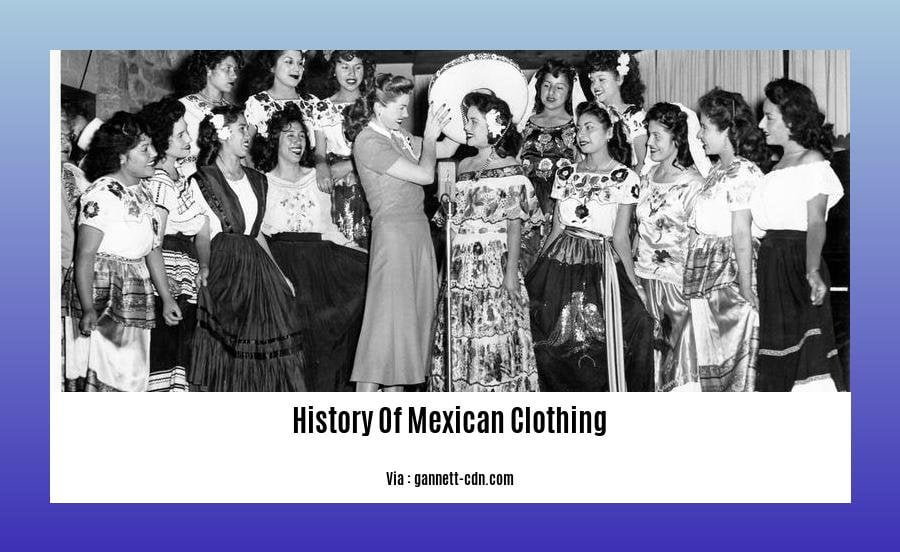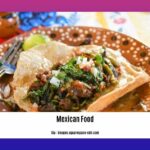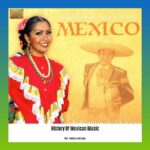Explore the fascinating world of Mexican clothing in our interesting piece, “Unveiling the Rich History of Mexican Clothing: A Journey Through Time and Culture.” Learn about how Mexican clothing has changed over time and how national heritage, social changes, and artistic expressions have all come together to make a beautiful tapestry of clothes. Get ready to be mesmerized as we look at the deep influences that have led to these amazing works’ unique styles, detailed designs, and hidden meanings.
Key Takeaways:
- Prior European influence, clothing was made from materials like agave, cotton, and tree bark, woven on a backstrap loom.
- The impact of Europeans resulted in the integration of wool, silk, and the introduction of the pedal loom.
- Mexican attire included separates for daily wear and special occasions, featuring intricate designs and vibrant colors.
- Women’s clothing embraced garments like skirts, blouses, and rebozos, while men donned shirts, trousers, and boots.
- Mexicans embraced a palette of vivid and earthy tones, including shades of brown, red, orange, green, and blue.
History of Mexican Clothing
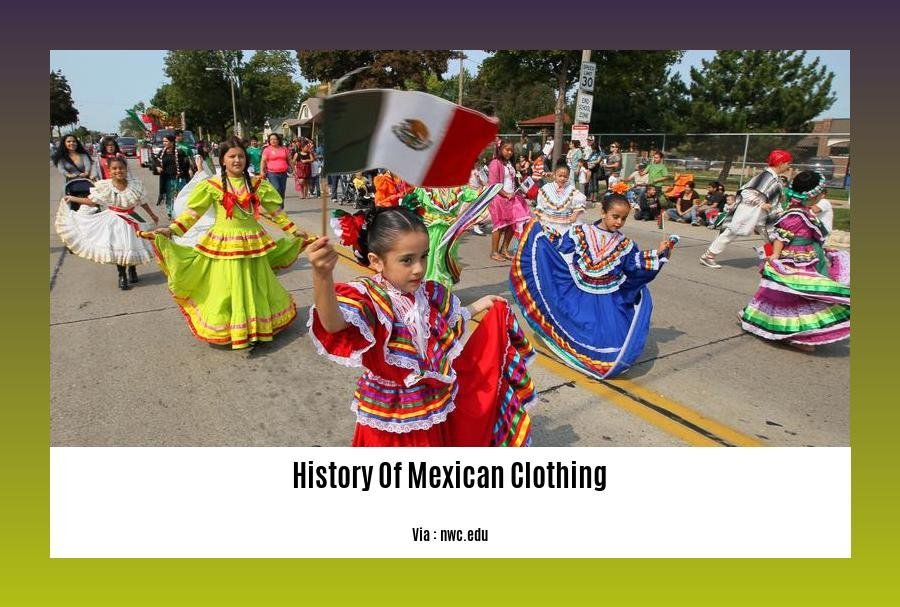
What people wear can tell us a lot about them, like their past and the weather where they live. Mexico’s clothing has a long and interesting past that goes back to before the Spanish came.
Before Columbus arrived
They wore clothes made from natural materials like cotton, maize fibers, and animal skins before the Spanish came to Mexico. Different parts of the world had different clothing types, but loincloths, skirts, and tunics were worn by most people.
Colonial Times
The Spanish coming to Mexico in the 1600s had a big effect on the clothes that people there wore. The Spanish came with new clothes and materials, like wool and silk. They also brought new styles, like cloaks, hats, and shoes.
Period after independence
After Mexico got its freedom from Spain in 1821, the clothes worn there started to change again. Mexican fashion makers started to get ideas from both native and European styles. This led to the creation of a unique style of clothing that was both old and new.
Modern Time Period
Traditional and modern styles can be found in a lot of different ways in Mexican clothes today. In rural places, people still wear traditional clothes like the huipil, rebozo, and sarape. But modern styles of clothes are also popular, especially in cities.
Characteristics of Style
Colors: Mexican clothing is famous for its bright colors, which come from the natural beauty of the country. Red, orange, yellow, green, and blue are all common colors.
designs: Mexican clothing often has very complicated designs that come from native textiles and art. Geometric shapes, flower patterns, and animal prints are all common patterns.
Mexican clothes often has embroidery on it as a way to decorate it. Clothes often have patterns embroidered on them to add color and detail.
Background in Culture
In Mexico, clothes often have a lot of traditional meaning.
Traditional Clothes: The huipil, rebozo, and sarape are all traditional Mexican clothes that are often linked to certain areas or ethnic groups. A lot of people wear them on holidays and other special events.
fabrics: Mexican fabrics are known for being beautiful and well-made. Traditional methods like hand-weaving and embroidery are used to make a lot of Mexican fabrics.
Significance: Elements of Mexican clothes that are symbolic are common. For instance, the colors and designs of a piece of clothing may mean certain things.
In conclusion
Mexican clothes have a long and interesting past. From its pre-Columbian roots to modern styles, Mexican clothing has always shown how the country’s many cultures and traditions are mixed together. Today, Mexican clothes is a lively and changing way of showing who you are as a Mexican.
- Explore the rich tapestry of Jamaica’s past through a detailed timeline, uncovering the pivotal moments that shaped this vibrant nation. history of jamaica timeline
- Immerse yourself in the history of the Malankara Orthodox Church, a steadfast guardian of Syriac Christian traditions in India, and discover its enduring legacy. history of malankara orthodox church
- Delve into the origins and evolution of the Mexican Hat Dance, a spirited folk tradition that showcases the infectious energy and cultural pride of Mexico. history of mexican hat dance
- Embark on a musical journey through the annals of Mexican music, tracing its roots from pre-Columbian times to the vibrant contemporary sounds that captivate audiences worldwide. history of mexican music
Mexican Revolution led to a resurgence of traditional clothing
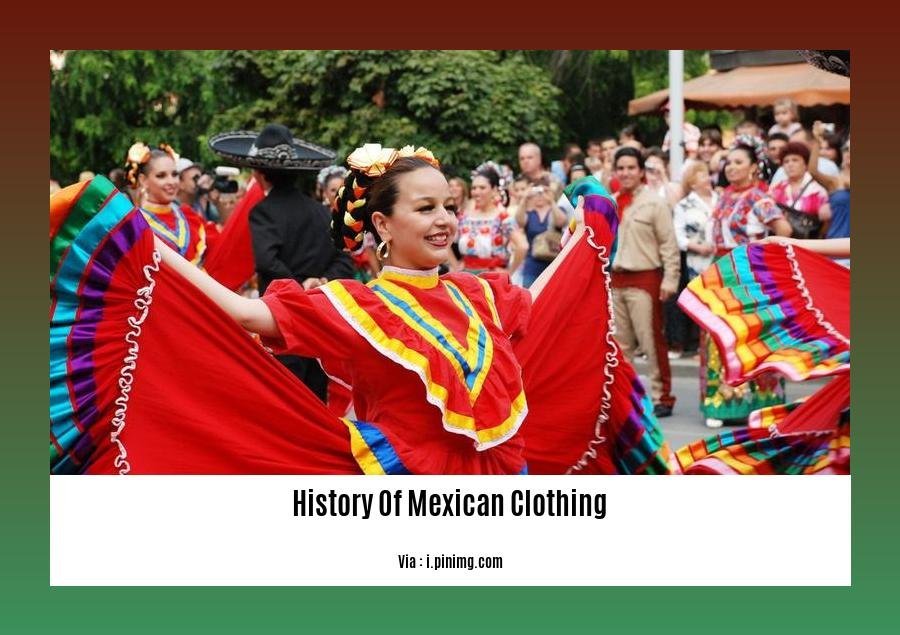
Traditional clothing came back into style during the Mexican Revolution, which led to a societal shift. There were a lot of reasons for this effort to bring back native styles.
First, the Revolution made people want to take back their Mexican identity after European invaders had stifled their culture for years. Wearing traditional clothes became a sign of national pride and a stand against outside influences.
Second, the Revolution caused a lot of people to move from the countryside to the cities, which brought people from all over Mexico together. As people from different countries got to know each other, they shared clothing styles and techniques, which led to a mix of traditional elements from across the country.
Third, the Revolution made Mexicans feel more nationalistic and united. People tried to show who they were through their clothes, which became a unifying sign of their shared history.
After the Revolution, people became interested in traditional Mexican clothes again. Native patterns and methods started to show up in the work of designers and artists, and traditional clothes became popular with people from all walks of life.
Key Takeaways:
- Symbol of Cultural Identity: Traditional attire became a symbol of national pride and resistance against foreign influences during the Mexican Revolution.
- Cultural Fusion: The mingling of cultures during the Revolution led to a fusion of traditional elements from various parts of the country.
- Expression of Unity: Traditional clothing became a unifying symbol of shared identity and common heritage among Mexicans.
- Artistic Revival: After the Revolution, designers and artists incorporated indigenous motifs and techniques into their work, leading to a renewed appreciation for traditional clothing.
- Renewed Popularity: Traditional garments gained popularity among all classes of society after the Revolution, symbolizing a resurgence of Mexican cultural identity.
Sources:
– Mexican Fashion and the Politics of Cultural Identity
– The History of Mexican Clothing
Modern Mexican fashion blends tradition and contemporary influences
Key Takeaways:
- Cultural Fusion: Modern Mexican fashion is a blend of traditional Mexican elements and contemporary influences from around the world, reflecting a rich cultural exchange.
- Vibrant Textiles: Mexican fashion showcases vibrant textiles, often adorned with intricate embroidery and artisanal techniques, paying homage to the country’s rich textile heritage.
- Traditional Meets Modern: Designers seamlessly merge traditional Mexican motifs with modern silhouettes and styles, creating unique and innovative designs that appeal to a global audience.
- Global Inspiration: Modern Mexican fashion draws inspiration from various cultures, incorporating elements of international trends while staying true to its Mexican roots.
- Symbolism and Identity: Traditional Mexican garments often carry symbolic meanings, representing cultural identity, regional heritage, and personal style.
- Cultural Revival: In recent years, there has been a resurgence of interest in traditional Mexican clothing, driven by a desire to preserve cultural heritage and promote national identity.
- Craftsmanship and Artisanship: Mexican fashion showcases exceptional craftsmanship and artistry, highlighting the skills and creativity of local artisans who create intricate textiles and embellishments.
- Sustainability and Ethos: Modern Mexican fashion embraces sustainability and ethical practices, promoting the use of eco-friendly materials and supporting local artisans and communities.
*Source:
- Mexican Fashion: A History of Tradition and Modernity
- Modern Mexican Fashion: Blending Tradition and Contemporary Influences*
Clothing reflects diverse cultural, regional, and indigenous influences
Have you ever been amazed by the bright colors, detailed embroidery, and unique styles that make up Mexican clothing? Don’t think of these clothes as just clothes; they’re a live example of the rich tapestry of Mexican culture, showing how different cultural, regional, and indigenous influences have shaped the country’s identity.
In Mexico, clothes have a lot of traditional meaning and are a powerful way to express yourself and show that you belong. The different climates and scenery across the country have had a big impact on the different ways people dress in different parts of the country. From the colorful blouses and flowing skirts of the central mountains to the intricately woven fabrics of the southern states, each area has its own style that comes from its own cultural background.
Native American groups in Mexico have done a lot to keep traditional clothing styles alive by passing down complicated methods and designs from one generation to the next. Their bright fabrics, which are often decorated with intricate needlework and beadwork, tell stories about their ancestors, their ties to the land, and their pride in their culture. The complicated patterns and designs on these clothes have deep symbolic meanings that show their beliefs, practices, and traditions.
By the time the Spanish came to Mexico during the colonial period, fashion had a mix of European and native styles. Spanish styles, like the rebozo shawl and the charro suit, became important parts of the Mexican clothing. They mixed with traditional native styles to make a unique look called mestizo. This mixing led to a huge amount of creativity, with clothes that showed how well European style and native art could work together.
Today, Mexican fashion is still changing, drawing from both its rich culture history and current fashions around the world. Modern designers are taking old styles and giving them new looks by using modern fabrics and cuts while staying true to the spirit of Mexican art. The result is a lively and exciting fashion scene that embraces modern tastes while honoring the country’s rich cultural diversity.
Key Takeaways:
- Mexican clothing is a vibrant reflection of the country’s rich cultural diversity, encompassing regional variations and indigenous influences.
- Indigenous communities play a crucial role in preserving traditional clothing practices and intricate textile techniques, imbuing their garments with deep symbolic meanings.
- The fusion of European and indigenous elements during the colonial era gave rise to a unique mestizo aesthetic, characterized by a harmonious blend of styles.
- Contemporary Mexican fashion blends traditional craftsmanship with modern trends, creating a dynamic and evolving fashion scene that celebrates cultural heritage and embraces global influences.
Sources:
- The History of Mexican Clothing: A Cultural Tapestry
- Mexican Clothing: A Reflection of Cultural Identity
FAQ
What kinds of materials did Mexicans use to make clothes before Europeans came?
According to A1, before Europeans came to Mexico, people made clothes out of agave, cotton, and wood. A traditional method called the backstrap loom was used to carefully turn these materials into clothes.
How did European styles affect the way Mexicans dressed?
A2: When Europeans came to Mexico, especially the Spanish, they brought big changes to the clothes that the native people wore. As new materials like wool, silk, and the pedal loom came out, they caused new styles and patterns to be made. European styles also affected the use of bright colors and complicated patterns, which became a signature of Mexican clothing.
If you’re in Mexico, what kinds of clothes do most women and men wear?
Answer 3: In traditional Mexican dress, women wear skirts, tops, and rebozos, which are long shawls. Often, these clothes are decorated with bright colors and elaborate embroidery. Men’s clothes, on the other hand, are usually made of long-lasting materials like leather or cotton and include shirts, pants, and boots.
Q4: What do the different colors mean in Mexican clothing?
A4: Colors are very important in Mexican clothes, and bright and earthy colors are especially popular. People often use different shades of brown, red, orange, green, and blue, which each represent a different part of Mexican culture and identity. People think that these colors show the country’s beautiful scenery, past, and traditions.
Q5: How has the clothing in Mexico changed over time?
A5: Throughout history, cultural, social, and political changes have caused Mexican clothes to change in many ways. For example, the Mexican Revolution was a big reason why traditional clothes became popular again as a sign of national pride and identity. Today, Mexican fashion is still changing. New designers are mixing traditional elements with modern styles to make one-of-a-kind looks that honor the country’s rich cultural history.
q
- Discover when was glass first made: Ancient origins & global impact - March 28, 2025
- Unlocking It’s Greek to Me: A History and Meaning - March 28, 2025
- Ancient Greece Clothing Styles: A Complete History - March 28, 2025
